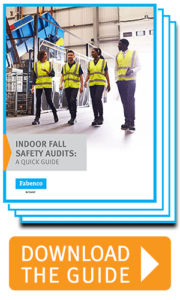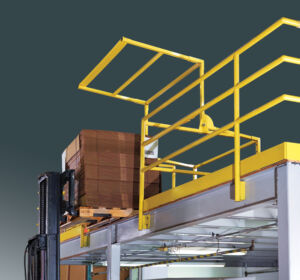
One of the most important responsibilities of managing a steel manufacturing company is to ensure employee safety. To stay successful, you must minimize the risk of injuries. In addition to the potential for human suffering, employee injuries can lead to paid time off, the need to hire or train new employees to replace injured workers, and lower overall productivity, which ultimately puts your company’s success at risk. Fall protection in particular is one of the most important factors in maintaining overall employee safety and the strength of your company.
Minimizing fall risks is extremely important. According to the CDC, fall injuries in the manufacturing sector is “one of the three leading sources of occupational injuries.” Falls can occur in a variety of areas, from stairways to loading docks to mezzanines and more. The key to fall protection and the prevention of fall injuries is to plan ahead and realize where falls are most likely to happen. It is your responsibility to create a plan to prevent such accidents by taking steps such as installing OSHA-approved fall protection safety gates in high-risk areas. These include:
Stairways
Stairs are an integral part of any steel manufacturing facility, and a prime area of fall safety concern. Stairways are used to navigate between floors and mezzanines, and can be located on the interior or exterior of the facility. Because they are used in industrial settings, these stairs are designed to carry a load five times greater than the standard anticipated load, with required handrails and guardrails that can withstand at least 200 pounds of pressure from any direction at any point. Workers often use stairs to move throughout the facility, sometimes while carrying equipment or other materials which can increase fall risk. Installing proper guardrails and an OSHA-approved safety gate is one of the best ways to minimize and prevent stairway related falls and accidents.
Ladders
According to OSHA 1910.23(a)(2), “Every ladderway floor opening or platform shall be guarded by a standard railing with standard toe board on all exposed sides (except at entrance to opening), with the passage through the railing either provided with a swinging gate or so offset that a person cannot walk directly into the opening.” This includes ladders that extend to another working surface. In other words, all ladderway floor openings and platforms must be protected by a standard railing with a safety gate at the entrance to the opening.
Gaps in guardrails
A safety gate is necessary at most guardrail gaps. Sometimes gaps are inevitable when guardrails are attached to objects that must be independently moveable during operation. However, precautions can be taken by minimizing the gap (a maximum opening of four inches to comply with 29 CFR 1910.23) or setting up safety gates for any gap wider than four inches. The point of a guardrail is to keep workers safe while they are working on an elevated platform, and any gaps in these guardrails could prove disastrous. Having a safety gate in place will prevent accidental fall injuries from gaps in guardrails.
Around machinery
Any consideration of safety in your facility must pay particular attention to actual steel manufacturing machinery. Unguarded machinery is one of the common causes of injury and illness in the steel industry, according to Safety Training Services. The machinery used in steel manufacturing makes facilities like yours one of the most hazardous work environments for employees…or it could, without the use of safety gates to prevent workers from coming into dangerous accidental contact with heavy machinery. Along with proper training of machine handlers, and limited access rules, safety gates provide an additional layer of protection for employees working with forklifts, blast furnaces, around robotics, and other common steel manufacturing equipment.
Loading Dock Areas
Fall safety on and around loading docks is also crucial. According to the Safety and Health Magazine, “about 25 percent of all reported warehouse injuries occur on loading docks, and for each incident hundreds of near misses occur.” According to OSHA standard 29 CFR 1910.23(b), relating to Protection for Wall Openings and Holes, “every wall opening from which there is a drop of more than 4 feet shall be guarded by an actual fall protection barrier.” As many loading dock platforms are within this range, loading docks are certainly an important place for installing safety gates to ensure worker safety.
Mezzanines
Elevated platforms installed between the floor and ceiling, mezzanines are an effective way to increase storage and work space by letting you utilize unused vertical space within your facility. However, increasing elevated platforms can also increase potential fall danger. While employees must be trained to work carefully and understand safety signals from those on the ground, having the right mezzanine safety gates in place is critical as a buffer for inevitable human error. These errors can be reduced when employees maintain proper practices and awareness, but a work environment that includes proper and complete installation of fall protection equipment is an absolute necessity.
There are four main types of mezzanines for industrial and commercial use, which require specialized mezzanine safety gates to protect your employees:
Free standing mezzanines: also known as structural, steel, or wide-span mezzanines, these mezzanines offer great flexibility in restructuring and set up, as needed.
- Building supported mezzanines: If a building is designed to support additional loads, a mezzanine or platform may be part of the structure.
- Rack supported mezzanines: These platforms create a mezzanine to offer usable space between storage racks, as long as the rack system itself is able to support these additional loads. Catwalks can also be installed in some cases.
- Shelving-supported mezzanines: These mezzanines are ideal for storing smaller items, making economical use of existing space.
The proper placement and installation of mezzanine safety gates is essential to make any or all of these mezzanine types safe.
Protect your employees’ safety to protect your company’s future
As someone who manages a steel manufacturing plant, you should know better than anyone the kind of risks your employees take every day to perform their duties properly. Steel manufacturing companies that fail to protect their employees’ safety are failing their workforce and their clients. Investing in safety guards such as mezzanine safety gates and railings is a significant investment, but in the long run, the prevention of injuries is imperative.
With proper prior planning, you can greatly increase fall safety, minimizing and hopefully eliminating fall injuries at your steel manufacturing company. All it takes is a little bit of thinking ahead and securing the proper safety equipment, with a regular inspection schedule to ensure that fall protection systems are properly maintained. Invest in safety gates for all of the risky and vulnerable areas in the work environment, and you will find that the investment pays for itself many times over. Without the stress of worrying over employee injuries and falls, you can get back to the work that makes your business successful for decades to come.




















